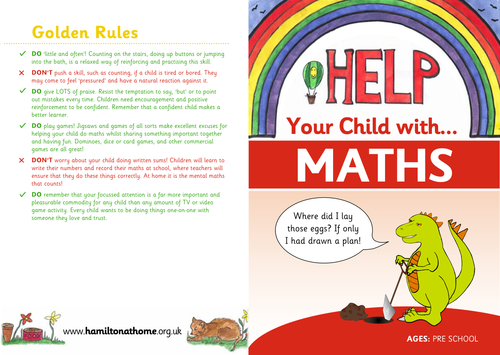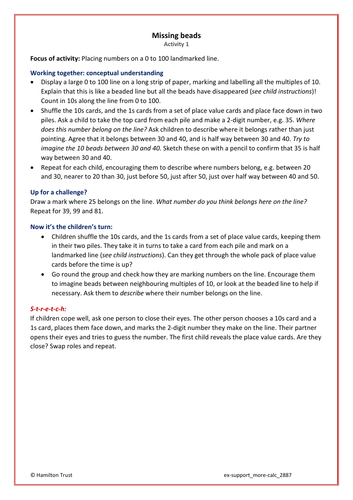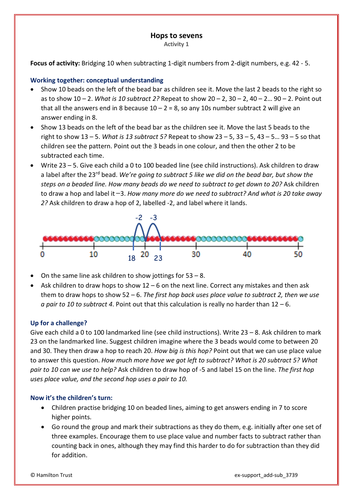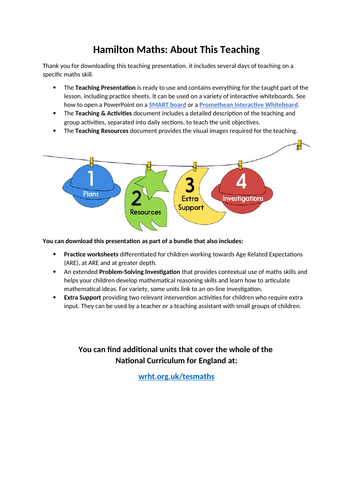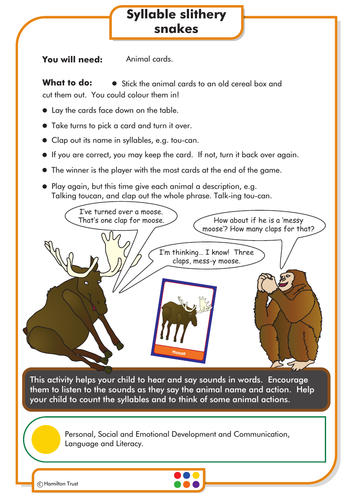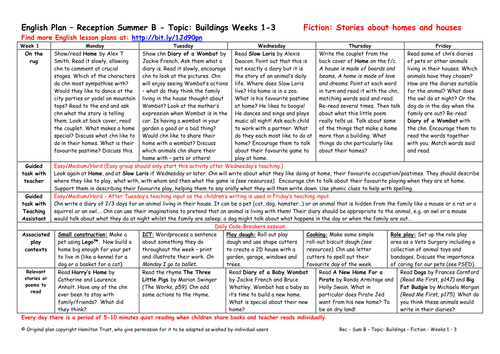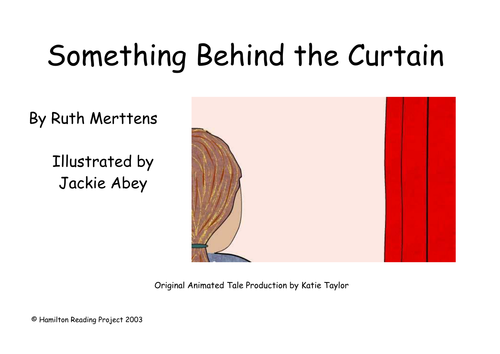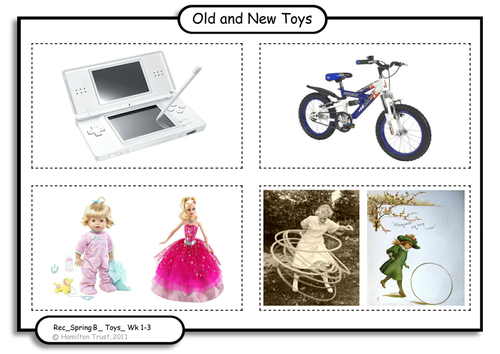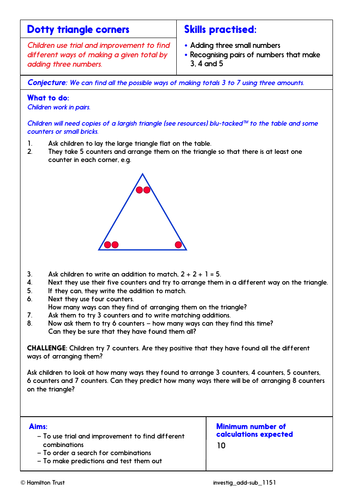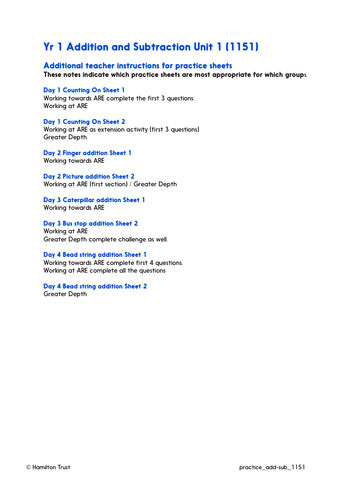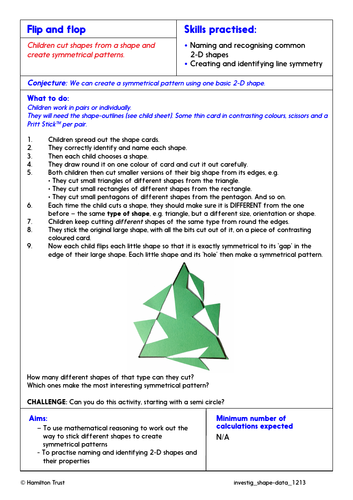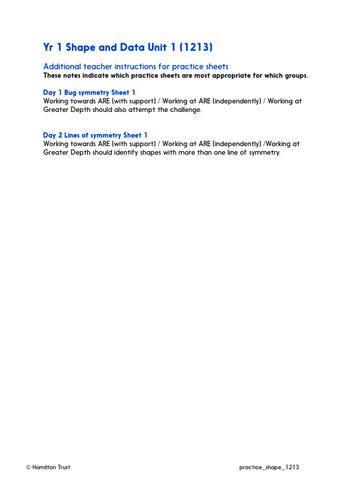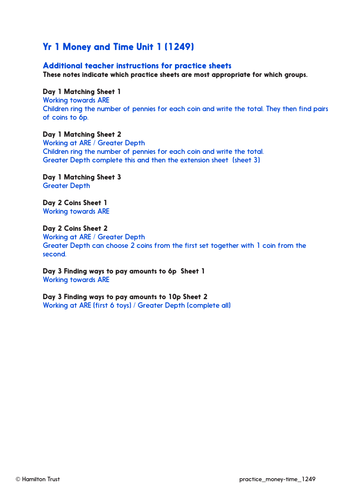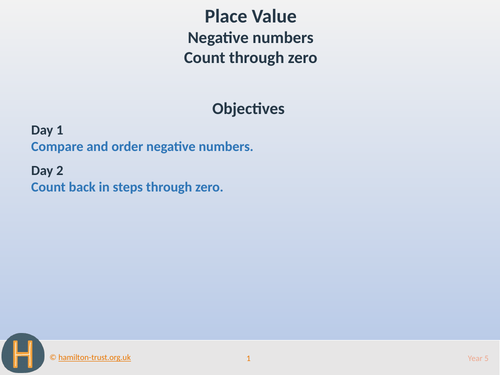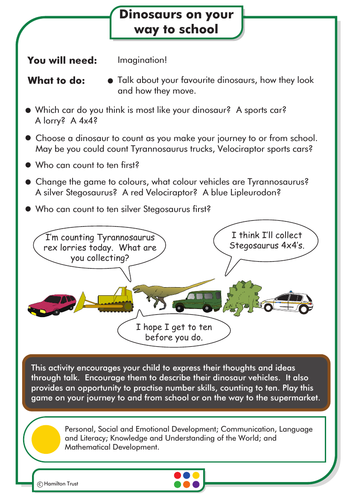
3k+Uploads
9988k+Views
11603k+Downloads
Maths for early years

Pre-School Maths Leaflet
A leaflet or parents of Pre-Schoolers giving them advice on how to use maths with their children in everyday life.

2- & 3-digit numbers on line; round to 10 - Extra Support Activity - Year 2
This activity is designed to be used by a teacher or a TA with children who need extra support before they can tackle these objectives: Placing 2-digit and 3-digit numbers on a line; rounding to nearest 10.
Missing Beads - Placing numbers on a 0–100 landmarked line
This Extra Support Activity is part of our Year 2 More Calculation block. Each Hamilton maths block contains a complete set of planning and resources to teach a term’s worth of objectives for one of the National Curriculum for England’s maths areas.

Add/subtract multiples of 10 and near multiples - Extra Support Activity - Year 3
This activity is designed to be used by a teacher or a TA with children who need extra support before they can tackle these objectives: Add/subtract multiples of 10 and near multiples.
Hops to Sevens - Bridging 10 when subtracting 1-digit numbers from 2-digit numbers, e.g. 42 - 5
This Extra Support Activity is part of our Year 3 Addition and Subtraction block. Each Hamilton maths block contains a complete set of planning and resources to teach a term’s worth of objectives for one of the National Curriculum for England’s maths areas.

Add/subtract multiples of 10 and near multiples - Teaching Presentation - Year 3
This presentation provides three days of teaching that cover the objectives:
Add/subtract multiples of 10 and 100.
Add/subtract near multiples of 10.
Use addition and subtraction to solve word problems including near multiples of 10.
It includes starter activities, whole class teaching, group activities, practice sheets and mastery questions. It can be used on a variety of interactive whiteboards.
Day 1 Teaching
Write 346 + 50. Which digit will change? Confirm it is just the 10s digit; model counting on in 10s from 346 to answer. Repeat with 231 + 30 and 636 + 20.
Write 376 + 50: Which digit will change? Count on in 10s to show how both 100s & 10s digits change. Repeat for 346 + 500, 336 – 50 and 846 – 500.
Day 2 Teaching
Show a grid from 301 to 400. Demonstrate adding or subtracting 10s by moving up or down the grid. What happens when we add a ‘nearly number’ like 39 instead of 40? We need to add 40, then adjust by subtracting 1. Repeat for adding and subtracting other nearly numbers, e.g. 356 + 41, 356 + 39, 356 – 39, 382 – 59, 338 + 29.
Day 3 Teaching
Display ‘Word problems’ one at a time; ask children to work on them in pairs. Think carefully about the maths that is needed – write a number sentence; then answer the question. Discuss their thoughts and clarify any misunderstandings as you work through each question. Choose one of the following to create a new word problem: 268 + 30, 583 – 40, 355 + 200, 632 – 400, 346 + 19, 475 – 21.
This teaching is part of Hamilton’s Year 3 Addition and Subtraction block. Each Hamilton maths block contains a complete set of planning and resources to teach a term’s worth of objectives for one of the National Curriculum for England’s maths areas.

Syllable slithery snakes (English Homework - Early Years)
English Homework activity for Early Years:
Hear and say the sounds in words and count the syllables in animal names in a fun card game (3 sheets).
Looking for English planning? Using high quality texts as a starting point, our creative and stimulating English plans incorporate grammar teaching in context and offer meaningful writing opportunities. Find out more at Hamilton Trust.
Bundle

English Homework - Early Years
English Homework activities for Early Years:
Animal sound families
Hear and say the initial sounds in words and understand which letters represent those sounds by playing an animal card game (3 sheets).
Dinosaur actions
Hear and say the initial sounds in words and start to understand which letters represent some of the sounds looking particularly at dinosaur actions beginning with the letter sound ‘d’ (2 sheets).
Dinosaur names
Hear and say the initial sounds in words and start to understand which letters represent some of the sounds by looking at dinosaur pictures (2 sheets).
How does a dinosaur move?
Use imaginative role-play and movement to move like a dinosaur using the dinosaur pictures and action words for ideas (3 sheets).
I-spy a dinosaur
Use talk to organise and clarify thinking to describe dinosaurs by playing I-spy with dinosaur toys or pictures (2 sheets).
Camel painting
Learn about camels and practise writing simple labels for their own camel pictures. Explore colour and shape to paint a camel (2 sheets).
Hello Mr Moose! What is your name?
Practise alliteration in a fun animal card game. Hear and say the initial sounds in words and understand which letters represent the sounds (3 sheets).
Living in the mountains
Explore what it would be like to live and go to school in the Himalayas. Learn a Kumaoni nursery rhyme off by heart (3 sheets).
Slippery snakes and leaping leopards
Use alliteration to describe the way some animals move and the sounds that they make. Hear and say the initial sounds in words and understand which letters represent those sounds (3 sheets).
Animal sequences
Talk about, recognise and recreate simple patterns in a simple animal sequencing game (2 sheets).
Dinosaurs on your way to school
Express thoughts and ideas through talk to describe dinosaurs, how they look and how they move by comparing them with different kinds of vehicles. Practise number skills, counting to 10.
Syllable slithery snakes
Hear and say the sounds in words and count the syllables in animal names in a fun card game (3 sheets).
Wanted!
Draw and write a short description of a missing animal in a ‘Wanted’ poster (2 sheets).

Reception Fiction (Buildings): Stories about homes and houses (weeks 1-3)
Listen to stories about different homes for people and creatures and decide where they would like to live, Home by Alex T Smith, The Town Mouse and the Country Mouse by Helen Ward, and Diary of a Wombat by Jackie French and Bruce Whatley. Children write their own version of The Town and Country Mouse and use The Lighthouse Keeper’s Lunch by Ronda and David Armitage to plan best lunches. Keep diaries, make lighthouses and stormy music.

Reception Non-fiction (Dinosaurs): Information texts (weeks 1-2)
Use a 'dinosaur egg' to stimulate discussion about eggs and dinosaurs. Have fun with a range of activities, count and sound out words (Harry and the Bucketful of Dinosaurs by Ian Whybrow and Adrian Reynolds, How do Dinosaurs Get Well Soon by Jane Yolen and Mark Teague), pelmanism, Top Trumps and Dinosaur Dash. Make various dinosaur-related objects, 'steal' dino eggs and draw and label dinosaurs.

Reception Non-fiction (Families): Names, captions and notices (weeks 1-2)
Discuss families and the various roles within them, read the following stories My Mum, My Dad, Me and You, all of which are by Anthony Browne and Don’t Let the Pigeon Drive the Bus and Don’t Let the Pigeon Stay Up Late by Mo Willems. Children write a book about someone who cares for them using similes and also notices for family members. They learn their address too. Activities include paper people, house plans, family portraits and names.

Reception Non-fiction (Space): Information and instructions (weeks 1-2)
Use the Animated Tale The Baby and the Rocket to introduce children to information texts. Compare facts and fiction. Make a large rocket and use photos of the construction to write instructions. Lots of activities for children to investigate both planets and rockets.

Reception Non-fiction (Toys): Labels, captions, list, descriptions (weeks 1-3)
Taking inspiration from I Love You Blue Kangaroo by Emma Chichester-Clark, children share favourite toys and write descriptions. They talk about toys from long ago with a visitor, learn about old bears and make a class toy museum of old and new toys writing factual statements for displays.

Problem-Solving Investigation: Adding by counting on (Year 1 Addition and Subtraction)
Year 1 Addition and Subtraction: Adding by counting on.
This in-depth Maths Investigation will develop maths meta-skills, and enable children to learn to think mathematically and articulate mathematical ideas.
In-depth Investigation: Dotty Triangle Corners
Children use trial and improvement to find different ways of making a given total by adding three numbers.
This problem-solving investigation is part of our Year 1 Addition and Subtraction block. Each Hamilton maths block contains a complete set of planning and resources to teach a terms worth of objectives for one of the National Curriculum for England’s maths areas.

Adding by counting on - Practice Worksheets - Year 1
Year 1 Addition and Subtraction: Adding by counting on. Procedural fluency practice worksheets to achieve maths mastery. Differentiated for children working towards Age Related Expectations (ARE), at ARE and at greater depth.
Day 1 - Work out the total of 2 dice.
Day 2 - Draw a picture to show the number sentence.
Work out totals of fingers.
Day 3 - Work out how many people there are on the bus after it stops at a bus stop.
Day 4 - Add number of beads on a bead string and write the matching number sentence.
These procedural fluency practice sheets are part of our Year 1 Addition and Subtraction block. Each Hamilton maths block contains a complete set of planning and resources to teach a terms worth of objectives for one of the National Curriculum for England’s maths areas.

Problem-Solving Investigation: Explore shapes; begin to understand symmetry (Year 1 Shape and Data)
Year 1 Shape and Data: Explore shapes; begin to understand symmetry.
This in-depth Maths Investigation will develop maths meta-skills, and enable children to learn to think mathematically and articulate mathematical ideas.
In-depth Investigation: Flip and Flop
Children cut shapes from a shape and create symmetrical patterns.
This problem-solving investigation is part of our Year 1 Shape and Data block. Each Hamilton maths block contains a complete set of planning and resources to teach a terms worth of objectives for one of the National Curriculum for England’s maths areas.

Practice Worksheets: Explore shapes; begin to understand symmetry (Year 1 Shape and Data)
Year 1 Shape and Data: Explore shapes; begin to understand symmetry.
Procedural fluency practice Worksheets to achieve maths mastery. Differentiated for children working towards Age Related Expectations (ARE), at ARE and at greater depth.
Day 1 - Find which bugs have a symmetrical and non-symmetrical pattern.
Day 2 - Circle the symmetrical shapes and draw a line of symmetry.
These procedural fluency practice sheets are part of our Year 1 Shape and Data block. Each Hamilton maths block contains a complete set of planning and resources to teach a terms worth of objectives for one of the National Curriculum for England’s maths areas.

Practice Worksheets: Identify coins to 10p; exchange for 1p coins (Year 1 Money and Time)
Year 1 Money and Time: Identify coins to 10p; exchange for 1p coins.
Procedural fluency practice worksheets to achieve maths mastery. Differentiated for children working towards Age Related Expectations (ARE), at ARE and at greater depth.
Day 1 - Ring pennies for each coin amount and write the total.
Day 2 - Add two coins together and write as a number sentence.
Day 3 - Find different ways to pay for amounts up to 10p.
These procedural fluency practice sheets are part of our Year 1 Money and Time block. Each Hamilton maths block contains a complete set of planning and resources to teach a term’s worth of objectives for one of the National Curriculum for England’s maths areas.

Problem-Solving Investigation: Coins to 10p: identify & exchange (Year 1 Money and Time)
Year 1 Money and Time: Identify coins to 10p; exchange for 1p coins.
This in-depth maths investigation will develop maths meta-skills, and enable children to learn to think mathematically and articulate mathematical ideas.
In-depth Investigation: Make 20
Children use coins and number shapes to make a total of 20.
This problem-solving investigation is part of our Year 1 Money and Time block. Each Hamilton maths block contains a complete set of planning and resources to teach a term’s worth of objectives for one of the National Curriculum for England’s maths areas.

Negative numbers; count through zero - Teaching Presentation - Year 5
This presentation provides two days of teaching that cover the objectives:
Compare and order negative numbers.
Count back in steps through zero
It includes starter activities, whole class teaching, group activities, practice sheets and mastery questions. It can be used on a variety of interactive whiteboards.
Day 1 Teaching
Discuss contexts in which we use negative numbers: temperature, depth, debts, etc. Launch the ITP Number Line. Choose –20 to 20 range. Click so that the numbers are not displayed on the tags. Children identify numbers. Mark –2 and –8. What numbers are in-between? Repeat with +3 and –4. Ask children to write a number between –15 and 15 on a whiteboard. Gradually create a human number line, with children negotiating their position in the line.
Day 2 Teaching
Show a horizontal counting stick. Identify the end as –10. Count from this to +10. Then start at –40 and count in steps of 5. Start at –100 and count in 10s. Start at –200 and count in 25s. Repeat, counting back and forth across 0 in different size steps. Discuss situations in ‘real life’ where these sorts of subtractions are possible, e.g. falls in temperature, descending below sea level, or being overdrawn at the bank.
This teaching is part of Hamilton’s Year 5 Place Value block. Each Hamilton maths block contains a complete set of planning and resources to teach a term’s worth of objectives for one of the National Curriculum for England’s maths areas.

Dinosaurs on your way to school (English Homework - Early Years)
English Homework activity for Early Years:
Express thoughts and ideas through talk to describe dinosaurs, how they look and how they move by comparing them with different kinds of vehicles. Practise number skills, counting to 10.
Looking for English planning? Using high quality texts as a starting point, our creative and stimulating English plans incorporate grammar teaching in context and offer meaningful writing opportunities. Find out more at Hamilton Trust.

